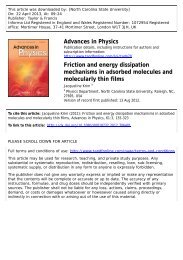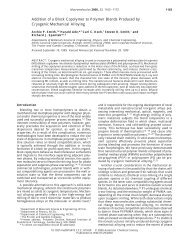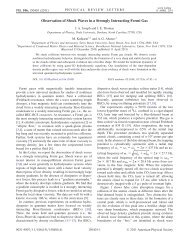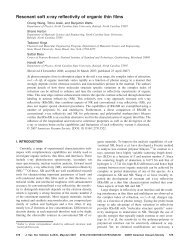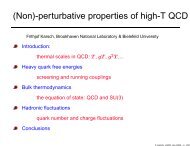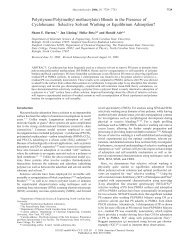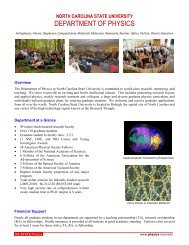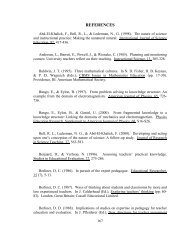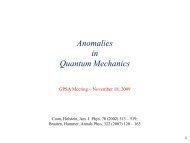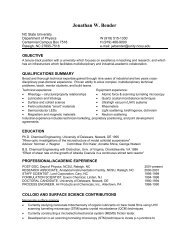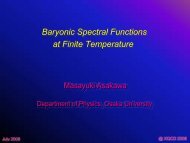Tribo-Induced Melting Transition at a Sliding Asperity Contact
Tribo-Induced Melting Transition at a Sliding Asperity Contact
Tribo-Induced Melting Transition at a Sliding Asperity Contact
You also want an ePaper? Increase the reach of your titles
YUMPU automatically turns print PDFs into web optimized ePapers that Google loves.
PRL 103, 205502 (2009) PHYSICAL REVIEW LETTERS<br />
week ending<br />
13 NOVEMBER 2009<br />
T ¼ qa k ; (1)<br />
where k ¼ 81:6 W=ðm KÞ is the thermal conductivity of<br />
indium.<br />
To calcul<strong>at</strong>e the he<strong>at</strong> flux supplied to the interface, we<br />
approxim<strong>at</strong>e the energy dissip<strong>at</strong>ion when the tip comes<br />
into contact with the QCM. We calcul<strong>at</strong>e the kinetic energy<br />
of the quartz/electrode system using the measured oscill<strong>at</strong>ion<br />
amplitude with a previously measured QCM amplitude<br />
distribution [30]. The dominant term of the kinetic<br />
energy (by 3 orders of magnitude) comes from the quartz<br />
crystal itself, taking the form:<br />
KE quartz ¼ 2R2 d½A$ cosð$tÞŠ 2 ð1 e 2b Þ<br />
; (2)<br />
16b<br />
with R the electrode radius, d the thickness of the crystal,<br />
(half of a wavelength when oper<strong>at</strong>ed in the fundamental<br />
mode), the density of quartz, ! the angular frequency, A 0<br />
the maximum amplitude of oscill<strong>at</strong>ion <strong>at</strong> the center of the<br />
electrode, t time, and b a constant of the amplitude distribution<br />
which we assume to be 3 [30]. Using the changes in<br />
amplitude from Fig. 1, we can find the change in energy per<br />
cycle, which when multiplied by the frequency yields the<br />
power dissip<strong>at</strong>ed. Figure 4 shows the results of these<br />
calcul<strong>at</strong>ions along with the calcul<strong>at</strong>ed maximum temper<strong>at</strong>ure<br />
rise assuming th<strong>at</strong> half of the dissip<strong>at</strong>ed power went<br />
into the indium as he<strong>at</strong> flux (with the other half going into<br />
the tungsten tip) <strong>at</strong> a contact radius of 200 nm. The results<br />
show th<strong>at</strong> ample energy dissip<strong>at</strong>ion is present to melt the<br />
indium.<br />
We have reported here our observ<strong>at</strong>ion of a velocity<br />
dependent transition from solid to liquidlike behavior for<br />
an STM tip in sliding contact with an indium electrode of a<br />
QCM, the first such observ<strong>at</strong>ion for a sliding asperity<br />
contact. The velocity dependent n<strong>at</strong>ure of the frequency<br />
shift implies a change in the mechanisms of frictional<br />
dissip<strong>at</strong>ion; e.g., the contact region changes from solid to<br />
liquid. An analysis of the change in kinetic energy of the<br />
QCM when the tip comes in contact with the substr<strong>at</strong>e<br />
shows th<strong>at</strong> ample energy is dissip<strong>at</strong>ed to melt the indium,<br />
with temper<strong>at</strong>ure studies indic<strong>at</strong>ing th<strong>at</strong> the onset of this<br />
transition is close to indium’s surface melting temper<strong>at</strong>ure.<br />
The results suggest th<strong>at</strong> the surface, r<strong>at</strong>her than bulk,<br />
melting point temper<strong>at</strong>ure is the more relevant quantity<br />
for tribological consider<strong>at</strong>ions.<br />
This work has been supported by the Extreme Friction<br />
MURI program, AFOSR No. FA9550-04-1-0381, and by<br />
NSF DMR0320743 and DMR0805204. D. B. Brenner and<br />
D. Irving are gr<strong>at</strong>efully acknowledged for many useful<br />
discussions.<br />
[1] S. T. P<strong>at</strong>ton et al., Nanotechnology 19, 405705 (2008).<br />
[2] G. Di Toro, T. Hirose, G. Pennacchioni, and<br />
T. Shimamoto, Science 311, 647 (2006).<br />
[3] N. M. Beeler, T. E. Tullis, and D. L. Goldsby, J. Geophys.<br />
Res. [Solid Earth] 113, B01401 (2008).<br />
[4] H. Blok, Proc. Inst. Mech. Eng. 2, 222 (1937).<br />
[5] T. Zykova-Timan, D. Ceresoli, and E. Tos<strong>at</strong>ti, N<strong>at</strong>ure<br />
M<strong>at</strong>er. 6, 230 (2007).<br />
[6] B. Vick, M. J. Furey, and K. Iskandar, <strong>Tribo</strong>l. Int. 33, 265<br />
(2000).<br />
[7] J. Krim, Am. J. Phys. 70, 890 (2002), and Refs. [95]–[102]<br />
therein.<br />
[8] A. M. Molenbroek, G. ter Horst, and J. W. M. Frenken,<br />
Surf. Sci. 365, 103 (1996).<br />
[9] K. B. Jinesh and J. W. M. Frenken, Phys. Rev. Lett. 101,<br />
036101 (2008).<br />
[10] F. Baletto and R. Ferrando, Rev. Mod. Phys. 77, 371<br />
(2005).<br />
[11] H. S. Nagaraj, D. M. Sanborn, and W. O. Winer, Wear 49,<br />
43 (1978).<br />
[12] S. C. Lim and M. F. Ashby, Acta Metall. 35, 1 (1987).<br />
[13] S. Bair, I. Green, and B. Bhushan, J. <strong>Tribo</strong>l. 113, 547<br />
(1991).<br />
[14] L. Kuipers, M. S. Hoogeman, and J. W. M. Frenken, Surf.<br />
Sci. 340, 231 (1995).<br />
[15] D. J. Bottomley, M. Iwami, Y. Uehara, and S. Ushioda,<br />
J. Vac. Sci. Technol. B 17, 12 (1999).<br />
[16] A. P. Merkle and L. D. Marks, Wear 265, 1864 (2008).<br />
[17] S. M. Lee and J. Krim, Thin Solid Films 489, 325 (2005).<br />
[18] B. Borovsky, B. L. Mason, and J. Krim, J. Appl. Phys. 88,<br />
4017 (2000).<br />
[19] D. J. Gunton and G. A. Saunders, Proc. R. Soc. A 343, 63<br />
(1975).<br />
[20] Handbook of the Physicochemical Properties of the<br />
Elements, edited by G. V. Samsonov (I F I/Plenum D<strong>at</strong>a<br />
Corpor<strong>at</strong>ion, New York, 1968).<br />
[21] B. Borovsky, J. Krim, S. A. Syed Asif, and K. J. Wahl,<br />
J. Appl. Phys. 90, 6391 (2001).<br />
[22] B. Du, A. M. King, and D. Johannsmann, New J. Phys. 10,<br />
053014 (2008).<br />
[23] B. Borovsky, A. Booth, and E. Manlove, Appl. Phys. Lett.<br />
91, 114101 (2007).<br />
[24] A. Laschitsch and D. Johannsmann, J. Appl. Phys. 85,<br />
3759 (1999).<br />
[25] M. Abdelmaksoud et al., Langmuir 22, 9606 (2006).<br />
[26] M. Herrscher, C. Ziegler, and D. Johannsmann, J. Appl.<br />
Phys. 101, 114909 (2007).<br />
[27] C. M. Flanigan, M. Desai, and K. R. Shull, Langmuir 16,<br />
9825 (2000).<br />
[28] A. Alessandrini, M. A. Croce, R. Tiozzo, and P. Facci,<br />
Appl. Phys. Lett. 88, 083905 (2006).<br />
[29] B. Bhushan, ed., Modern <strong>Tribo</strong>logy Handbook (CRC<br />
Press, Boca R<strong>at</strong>on, 2001), Vol. 1.<br />
[30] B. A. Martin and H. A. Hager, J. Appl. Phys. 65, 2630<br />
(1989).<br />
205502-4




